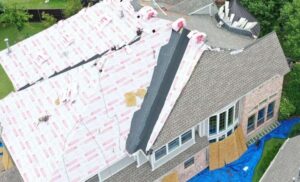Gutters are crucial to your home’s drainage system. They protect the structure of your roof and other house areas by diverting rainwater away from the foundation. They are also helpful if your home is on an upward slope.
However, they can easily become clogged with debris like sticks and leaves. This will prevent them from doing their job and can cause damage to your home. Click the Visit Website to learn more.

Gutter’s purpose is simple—to catch and direct rainwater away from the roof. They are usually located on the eave and connect to downspouts, which divert water into your garden or sewer system. Gutter’s prevent soil erosion, basement flooding, and mold and mildew growth. They are also crucial in keeping your property’s foundation safe by directing rainwater into drains and away from the home’s foundation.
Without gutters, rainwater will fall directly onto the walls of your house and cause rot and mold. It can also damage your siding, windows, and foundation. It will also collect around the windows and sills and drip down the wall, causing moisture to build up behind the trim and in the room’s corners. The humidity can also damage the fascia boards and soffits, causing rot, and the paint may chip.
Gutters help to prevent this damage by catching the water and directing it into downspouts and other drainage systems. They can be made from wood, aluminum, or steel and come in various shapes and styles. They can be square, round, K-style, or half-round. They can also be made of corrugated or seamless metal. There are many different types of gutters on the market today, each with its benefits and drawbacks.
For gutters to work effectively, they need to be properly installed and maintained. This will ensure that they are clear of debris, and that the downspouts are in the correct location to catch the rainwater. There are also a number of other components that are essential to a good gutter system, including downspout extensions and splash blocks. The extensions are used to increase the capacity of a downspout and can be attached in multiple locations. Splash blocks are concrete blocks that rest at the base of a downspout and help to disperse the water more evenly.
The gutter system is a crucial part of any home, and should be kept in good condition at all times. Regular maintenance and inspections will help to keep it functioning correctly and protect your property from potential damage. Gutter systems can be expensive to repair or replace, so it is important to take care of them as soon as you notice signs of wear and tear.
They divert water away from your home.
Gutters help to manage the flow of rainwater and protect your roof, walls, windows, foundations, landscaping, driveways, and sidewalks from moisture damage. They are installed along the edge of the roof and direct rainwater into downspouts or drains, which then channel the water to ground level or into an underground drainage system. Without gutters, this water would pool around the foundation of your home and seep through cracks in the wall and into your basement, causing serious problems that can cost thousands to repair.
Gutter downspouts are built at a slight downward slope to allow the water to flow freely towards a splash block or drain, which rests on the ground and slows down the force of the water. The splash block also keeps the water from spilling over the sides of the gutter, which can cause splashing and flooding issues. The gutter downspouts can also be redirected to a rain-harvesting tank, which allows you to catch the rainwater and repurpose it for landscaping, lawn watering, or other household uses.
A gutter can be made from a number of different materials, including copper and galvanized steel. Aluminum is the most common, and it can be formed into a wide variety of styles to match your home’s facade. It is low-cost and doesn’t rust, making it the ideal choice for many homeowners. Copper is more expensive, but it is a popular choice among upscale homeowners due to its beauty and natural luster.
Adding gutter extensions or downspouts is another way to improve the function of your gutters. These are tubes that can be added to the bottom of a downspout to divert the water even further away from the home, which helps to prevent overflow and water accumulation near the foundation.
Other gutter accessories include a leader band, a metal strip that is bent to form around the gutter and used to “strap” it to the home; and a drain well, which is a concrete block placed under the downspout to help with water flow and to keep out debris. These are all important components of a properly functioning gutter system and should be checked regularly.
They protect your home’s foundation.
While it may not be the most glamorous part of your home’s maintenance, gutters are a critical safeguard against costly damage that often stems from rainwater. Without a working gutter system, your house could be left vulnerable to a host of issues that affect its foundation and stability. Gutters serve as a silent guard, channeling water that would otherwise flood the soil around your foundation and threaten its stability.
When water pools around the foundation of your house, it can erode the soil and lead to cracks in the basement walls. It can also cause hydrostatic pressure to build up against the basement walls, which can cause them to bow inward and compromise their structural integrity.
A well-functioning gutter system can prevent this by directing rainwater away from the house and into a drainage system. However, this is only possible if the gutters are free from clogs and downspouts are properly extended so they drain at least 10 feet from the foundation of your house.
When gutters fail to function as they should, the excess water that isn’t able to drain down the downspout will simply overflow and pool around your foundation. This spilt water is a major factor in the formation of foundation leaks.
Additionally, over time, the accumulating water can swell and put pressure on the foundation of your house, which can eventually cause it to shift and crack. Gutter systems are designed to help prevent this by redirecting the water flow away from your house and into a broader drainage system.
Gutter systems do more than protect your foundation, though. They also help preserve your landscaping by diverting runoff from the roof and away from the edge of the house. This prevents soil erosion that can cause problems with your lawn and garden. It can also protect the integrity of your driveways, sidewalks, and patios by keeping them from becoming muddy and saturated with water that can leave marks on them. In addition, over time, stagnant water can become a breeding ground for mosquitoes in the summer and ice dams in winter.
They protect your roof.
Gutters play a crucial role in managing rainwater, protecting the roof, preventing soil erosion, minimizing flooding, preserving fascia and soffit, and preserving landscaping features. In addition, gutters help to prevent structural damage by directing water away from the foundation of your home.
Without gutters, or with clogged gutters, rainwater will collect on your roof and overflow, eventually causing shingle deterioration and leading to leaks in your home. Gutters are designed to protect the entire structure of your roof, including the shingles and underside. When your gutters are properly installed and regularly maintained, they will keep water away from the roof, preserving it for years to come.
In addition to preventing the overflow and leaking of rainwater, gutters also keep your roof from being damaged by the sun’s UV rays. During the day, the sunlight’s UV rays can cause your roof to degrade and become discolored over time. If your gutters are not in good condition, the UV rays can penetrate the shingles and cause rot and other issues. With properly working and functioning gutters, your roof will be protected and will remain a solid investment for your home.
Rainwater that lands on your house’s foundation can cause severe damage to the structure and your property. The water can cause cracks in the foundation and the walls of your home, as well as rotted fascia and soffit. Moreover, the water can also seep through the foundation and enter your home, damaging the inside of your house. Gutters can prevent this damage by directing the rainwater into downspouts, where it will be directed away from your home’s foundation.
A downspout is a metal pipe that diverts water from the gutter system. Downspouts are typically installed at the bottom of the Leader, pointing down and away from the home. They can be extended with downspout extensions, which are additional pipes that extend the length of the downspout. Alternatively, you can use a rain barrel to store and direct the excess water from your house. Downspout extensions and a rain barrel are an inexpensive solution to keeping your home’s foundation safe from major damage.



